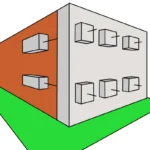What is Reinforcement Steel?
Reinforcement steel, also known as rebar or steel reinforcement, is a type of material used in construction to strengthen and increase the resistance of concrete structures. It consists of steel bars or wires strategically incorporated into concrete elements, such as columns, beams, and slabs, before the concrete fully hardens. The main purpose of reinforcement steel is to provide additional tensile and flexural strength, improving the structure’s ability to withstand loads and forces while preventing cracking and concrete failure under heavy loads.
Properties of Steel Structures
Reinforcement steels play crucial roles in the construction of concrete structures, contributing to strengthening and ensuring the integrity of buildings. Here are some key functions:
Tensile Strength: Concrete is excellent at withstanding compressive loads but less effective in resisting tensile forces. Reinforcement steels counteract this weakness as they are highly resistant to tension. By incorporating steel bars or mesh into concrete, its ability to withstand stretching forces is significantly improved, essential in the construction of beams, columns, and slabs experiencing tension due to loads or movement.
Crack Prevention: Concrete tends to crack when subjected to tension or loads. Reinforcement steels help prevent the formation and propagation of cracks in concrete, maintaining the structural integrity of the construction and avoiding severe damage. This is particularly crucial in structures exposed to adverse weather conditions or ground movements.
Increased Durability: The inclusion of reinforcement steels enhances the durability of concrete structures by protecting them from wear and corrosion. This is essential in applications where structures are exposed to aggressive environments or extreme weather conditions. Reinforcement steels contribute to structures maintaining their strength and appearance over time.
Support for Heavy Loads: In construction projects that must bear extremely heavy loads, such as bridges, skyscrapers, or industrial facilities, reinforcement steels are essential. They provide the extra strength needed to ensure the structure can safely withstand significant loads without suffering damage or excessive deformation.
Improved Ductility: Ductility refers to a material’s ability to deform before breaking. Reinforcement steels, by providing additional strength to concrete structures, enhance their ability to deform instead of breaking abruptly under extreme loads. This is particularly important in seismic zones, where structures need to absorb and dissipate earthquake energy in a controlled manner.
Contribution to Safety: Reinforcement steels play a crucial role in the safety of structures. By ensuring that concrete maintains its integrity and strength, they help prevent collapses and catastrophic damage in extreme events such as earthquakes or exceptional loads.
Manufacturing Process
The manufacturing process of reinforcement steels is fundamental to obtaining high-quality products that meet the necessary standards and requirements for strength and durability in reinforced concrete construction. The typical manufacturing process of reinforcement steel bars is described below:
Raw Material Selection: The process begins with the selection of high-quality raw materials, primarily steel scrap and iron ore. The scrap is melted in electric or arc furnaces at high temperatures to obtain liquid metal.
Steel Refinement: The liquid metal undergoes refinement processes to remove impurities such as sulfur and phosphorus, which can weaken the steel. This step is crucial to ensuring the final product’s quality.
Continuous Casting: After refinement, the liquid steel is poured into continuous casting molds, where it solidifies into ingots or billets. These ingots are cooled and cut into suitable lengths for the rolling process.
Hot Rolling: The billets are heated to high temperatures and passed through a series of rollers that gradually reduce their size, transforming them into reinforcement steel bars. During this process, the bars deform, acquiring the required shape and mechanical characteristics.
Controlled Cooling: After hot rolling, reinforcement steel bars undergo a controlled cooling process to ensure they achieve the proper strength and hardness.
Cutting and Marking: Steel bars are cut into specific lengths and marked with essential information, such as manufacturer identification, bar diameter, and other data required for tracking and identification.
Straightening and Stretching: Reinforcement steel bars may undergo additional processes, such as straightening and stretching, to ensure they meet dimensional tolerances and straightness requirements.
Quality Testing: Quality tests, including tensile tests and bending tests, are conducted to verify that the bars meet the required specifications.
Packaging and Storage: Finally, reinforcement steel bars are appropriately packaged and stored in controlled conditions to prevent corrosion before being shipped to construction sites.
It is important to note that the manufacturing process of reinforcement steels is carried out under strict quality controls and complies with international regulations and standards to ensure the safety and durability of reinforced concrete structures.
Presentations of Reinforcement Steel
Corrugated Bars
These steel bars have a rough outer surface with spiral or corrugated reliefs along their length. Corrugated bars provide excellent adhesion to concrete, making them ideal for reinforcing structural elements such as columns, beams, and slabs. They come in various diameters and lengths to suit different construction applications.

Electro-Welded Mesh
Electro-welded steel meshes consist of a network of steel wires welded together in square or rectangular patterns. They are commonly used in paving projects, retaining walls, and slab reinforcement. Electro-welded meshes offer uniform reinforcement across the entire concrete surface, improving tensile strength and preventing crack formation.

Chipa Bar (Stirrups)
Chipa bars, also known as stirrups, are small steel bars bent into circular or rectangular rings. They are used to confine and reinforce concrete columns, preventing them from deforming or collapsing under loads. Stirrups are crucial for maintaining structural integrity in vertical structures such as buildings and bridges.

Prestressed Wires
These steel wires are designed for prestressing applications, where they are stretched before being incorporated into concrete. When the tension is released, they exert compressive force on the concrete, enhancing its ability to withstand loads. Prestressed wires are commonly used in the construction of bridges, precast beams, and large concrete elements.
Each of these presentations of reinforcement steel has specific characteristics that make them suitable for different construction applications, contributing to the strength and durability of concrete structures.
Most Common Commercial Diameters in Steel Bars:
Reinforcement bars come in a variety of diameters chosen based on the specific needs of a construction project. The most common diameters for steel bars in construction include:

The choice of the appropriate diameter depends on engineering calculations and project specifications. A larger diameter provides greater load-carrying capacity and strength but may also affect handling and installation ease. It is important to comply with local regulations and construction standards when selecting the diameter of steel bars to ensure the safety and durability of the structure.
Corrosion in Reinforcement Steel

Corrosion is a natural chemical process whereby metals, such as reinforcement steel, react with oxygen and other elements in the environment to form oxides, resulting in the gradual degradation of the metal. In the context of construction, corrosion of reinforcement steel in concrete can be problematic, as it may weaken structures and compromise their durability. Here is information on corrosion and precautions to prevent it:
Factors Contributing to Corrosion of Reinforcement Steel:
Exposure to the environment: Structures located in coastal areas or high-humidity regions are more susceptible to corrosion due to the presence of salinity and moisture in the air.
Concrete cracks and defects: Cracks in concrete allow water and oxygen to reach the reinforcement steel, accelerating corrosion.
Chemical contaminants: Aggressive chemical agents, such as chloride, can penetrate concrete and trigger corrosion.
Precautions and Care to Prevent Corrosion:
Protective covers: Use an appropriate concrete cover to shield reinforcement steel bars from direct contact with water and oxygen.
Concrete coating: Apply a suitable thickness of concrete coating over reinforcement steel to provide a protective barrier.
Corrosion-inhibiting additives: Add chemical additives to the concrete to help prevent corrosion of reinforcement steel.
Crack control: Minimize the formation of cracks in concrete through proper construction practices and the placement of expansion joints.
Proper drainage: Ensure that the structure’s drainage system functions correctly to prevent water accumulation.
Regular maintenance: Periodically inspect and maintain concrete structures to detect signs of corrosion and take corrective measures in a timely manner.
Use of galvanized or coated steel: In applications where corrosion is a significant risk, galvanized or coated steel bars resistant to corrosion can be used.
Application of anti-corrosive paint: In structures exposed to the environment, such as bridges, anti-corrosive paints can be applied to protect reinforcement steel.
Sustainability of Reinforcement Steel Application in Construction
The sustainability of reinforcement steels is a relevant and increasingly important topic in the construction industry. Education on sustainable construction practices and the responsible use of materials, such as reinforcement steels, is essential. Here are sustainability principles in the use of these elements:
Recyclability
Reinforcement steels are largely recyclable materials. At the end of their lifespan in a structure, reinforcement steel bars can be recovered, recycled, and reused in the manufacturing of new steel products. This recycling process helps reduce the demand for natural resources and minimizes construction waste.
Durability
Reinforcement steels are designed to be durable and corrosion-resistant. This means that reinforced concrete structures using reinforcement steel can have a longer lifespan, reducing the need for replacement and, consequently, decreasing the environmental impact associated with demolition and the construction of new structures.
Lower Maintenance
The corrosion resistance of reinforcement steels reduces the need for maintenance throughout the lifespan of a structure. This saves resources and reduces costs associated with maintenance and repairs while prolonging the structure’s lifespan.
Energy Efficiency
Reinforced concrete structures using reinforcement steels may have thermal insulating properties, contributing to the energy efficiency of buildings. This can result in lower energy consumption for heating and cooling, subsequently reducing greenhouse gas emissions.
Lower Carbon Footprint
The production of reinforcement steel has advanced in terms of energy efficiency and carbon emission reduction in recent years. Steel companies are adopting more sustainable practices and advanced technologies to minimize their carbon footprint.
Material Innovations
Research and development continue to seek more sustainable reinforcement steel materials, such as recycled steel and products with lower carbon content. These innovations aim to further reduce the environmental impact of construction materials.
Certifications and Standards
There are certifications and standards that assess and promote the sustainability of construction materials, including reinforcement steels. Certifications like LEED (Leadership in Energy and Environmental Design) can reward the use of sustainable materials in construction projects.
Conclusion
Reinforcement steel plays an essential role in the construction of concrete structures by providing additional tensile strength, enhancing durability, and preventing cracking. Its manufacturing process adheres to strict quality standards to ensure its suitability in construction applications.
Furthermore, sustainability in the use of reinforcement steels has become a key aspect in the construction industry. Their recyclability, durability, and energy efficiency contribute to reducing the demand for natural resources, minimizing construction waste, and decreasing the carbon footprint, thus promoting more environmentally responsible construction practices.
In a world where sustainability and durability are increasingly important, the proper use of reinforcement steels not only strengthens structures but also contributes to the well-being of the planet and the development of safer and more sustainable constructions.







Related
What is Moment of Inertia in Engineering?
Metal Structures
What Are Trusses? – Civil Engineering